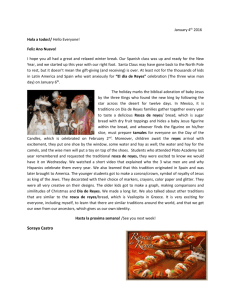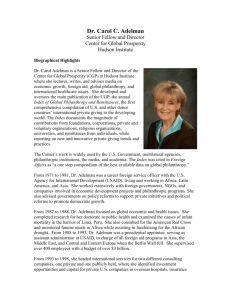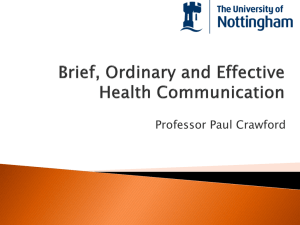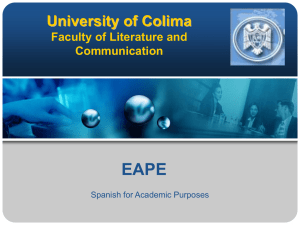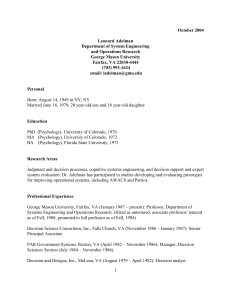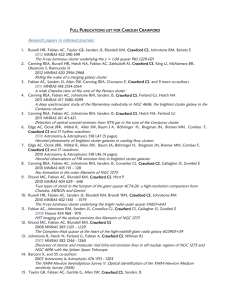A Diary of a Bilingual School
advertisement
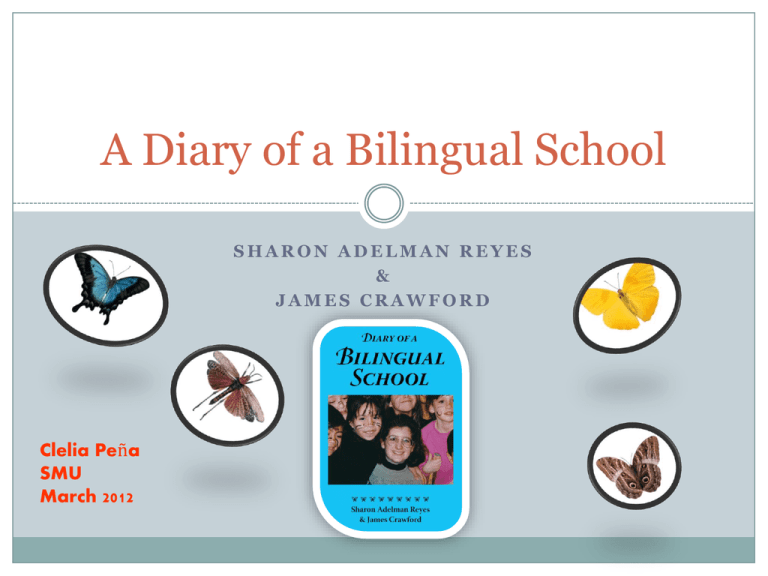
A Diary of a Bilingual School SHARON ADELMAN REYES & JAMES CRAWFORD Clelia Peña SMU March 2012 Introduction A YEAR IN THE LIFE What happens when the instruction is bilingual and the curriculum is constructivist? Inter-American Magnet School in Chicago, Illinois A year in the life of a 2nd grade classroom Classroom and family narratives taken from an ethnographic study conducted during the 1995-96 school year. This book focuses on this school’s progressive educational philosophy, curriculum and methodology. Chapter 1 MAKING SENSE OF THE WORDSAND THE WORLD A school began… Janet Nolan and Adela Coronado-Greeley (parents & educators) Immersion programs introduced in Quebec, Canada in the mid 1960s Initially, 50-50 model, focus on English development Finalized 80-20 ratio of Spanish to English from PK4th, combined with ESL and SSL (Spanish as a second language) as needed. In grades 5-8 the ratio shifts to 50-50. Inter-American Magnet School Dual language model in which both language are used for meaningful purposes The constructivist values- questioning, reasoning, analysis, reflection, problem solving, cooperation and creativity Children from Spanish and English backgrounds are brought together to create a bilingual and bicultural environment Parental involvement a high priority By the 1990s, Inter-American enrolled more than 600 students from Pk-8th grade Chapter 2 PRINCIPLES & PRACTICES Successful Dual language models Additive bilingualism and biliteracy Mix of language groups Cross-cultural emphasis Stress on sheltering Language separation Linguistic balance Classroom resources Long-term approach Instructional consistency Assessment Personnel quality Professional collaboration Home-school relations Constructivist Strategies Goals Cognitive Development Disequilibrium Inquiry Scaffolding Social Interaction Motivation Vision of Inter-American “A caring, cooperative and accepting school climate… to promote the social, affective, and cognitive development of the whole child, in which the parents are active partners in the formal schooling of their children.” Chapter 3 WELCOME TO ROOM 307 Ms. Sontag and 18 bilingual collaborators Who were the children? Half came from low income families, the rest were middle class Majority had Latino roots, many came from bicultural roots Ethnicities: Mexican, Puerto Rican, Guatemalan, Colombian, Ecuadorian, Belizean, Panamanian, Filipino, Jewish, African American and white Anglo-Saxon Protestant. Language backgrounds ranged from English monolingual to Spanish dominant to everything in between. It all started with a bug… “And Ms. Sontag, always ready to experiment with curriculum, wondered what she might do with the sudden explosion of interest that had just occurred in her classroom” (Adelman Reyes & Crawford, 2012, p.33) Chapter 4 THE WORMS HAVE ARRIVED! Building on prior knowledge ¿ Alguna vez has visto un insecto? Students’ investigation of gusanos de harina Vocabulario de insectos Variety of books (English and Spanish) Calendar and data collection sheet Building “casas” for their gusanos Feeding and caring for their gusanos Recording observations in diary A Lullaby for Worms Nuestros gusanos Son bonitos, Son bonitos, Son bonitos. Nuestros gusanos Son chiquitos, Son chiquitos, Son chiquitos. Nuestros gusanos Son rojo café, Son rojo café, Son rojo café. Nuestros gusanos Duermen mucho, Duermen mucho, Duermen mucho. Verónica- Puerto Rican father, English dominant parents But what about the tests? “At Inter-American tests are just one type of information used to improve curriculum and instruction” (Adelman Reyes & Crawford, 2012, p. 53). “Unless kept in perspective, standardized testing can restrict- and even shapecurriculum and instruction” (Adelman Reyes & Crawford, 2012, p. 54). Chapter 5 “NINCAS AND NINFAS” Integrating Language, Content and Process In this case, subject matter (content) is insect study, the language is Spanish and the process is discovery learning. “Answers are NOT given, children are instead encouraged to discover them on their own” (Adelman Reyes & Crawford, 2012, p. 63). Developing Vocabulary in Spanish As students learn through their scientific inquiry, they will engage in formal discussions of the life cycle of insects. And to do, they will need the appropriate words. “When tied to inquiry & and interesting context, vocabulary development can be fun” (Adelman Reyes & Crawford, 2012, p. 65) A new birth! “According to constructivist theory, when we make sense of our world, we are in a state of equilibrium. When this balance is upset, when things turned out differently from what we expect we experience the opposite sensation. This state of disequilibrium, prompting us to reconcile what we know (or think we know) with what we are now experiencing, creates ideal conditions for learning” (Adelman Reyes & Crawford, 2012, p.76). Chapter 6 BEETLES AND BUTTERFLIES El ciclo de vida de la mariposa Huevo Oruga ( o larva) Crisálida Mariposa New life- New learning “The Daily Bug Garden” “Today in class 307 they got new butterflies some have not come out of there cocoons and they are white. Everybody is excited. Leticia a second grader felt that at first the butterflies were caterpillars then they were cocoons then they were butterflies but one died. Wendell and Damion said, “They first came out of the cocoon and one died. They put out garbage. It looked like blood. Leticia also said that the butterflies’ color was red, orange, black and white. Liset said that the color of the butterflies came in May. Camilo said that they came to the class on Friday, May 27, 1996.” Naomi (Adelman Reyes & Crawford, 2012, p. 91) Cultivating Biliteracy Literacy is developed in the course of meaningful and functional activities. As Stephen Krashen explains, “Once you can read, you can read” (As cited in Adelman Reyes & Crawford, 2012, p.90). Chapter 7 GOODBYE, MRS. BEE Alicia’s secret Students as Teachers In constructivist classrooms, “Teachers learn alongside their students, and students become teachers or sometimes facilitators of the learning environment” (Adelman Reyes & Crawford, 2012, p.97). Chapter 8 SCHOOLING FOR LIFE Where are Ms. Sontag’s students now? Students are now in their twenties! Some are starting careers, while others are traveling, finishing college, or continuing other forms of education. All of them remain speakers of Spanish as well as English. Several are using Spanish on the job in the United States as translators, community advocates, business people or bilingual teachers. A few have acquired additional languages. Those who were native Spanish speakers retained their language, unlike many of their relatives. What do they say about their experience? “Beyond bilingualism and biculturalism, InterAmerican offered a curriculum that stimulated children’s appetite for learning. As they look back, graduates use words like creativity, independence, confidence, free-thinking and problem solving to describe what they remember the most about their experience. These qualities have had an obvious impact on their educational and career choices” (Adelman Reyes & Crawford, 2012,p. 111). What did I learn? So MANY things! (for instance that so much teaching can stem out from Science!) This book INSPIRED me, empowered me to DREAM, and gave me HOPE. Este LIBRO me ha impulsado a definir una visión. I feel like this book has summarized what I’ve been learning in all of my master classes. Correlation to class My article- science & literacy Strategies book Discovery Learning (videos) Academic Language as it relates to all content areas Sheltered Instruction Tech High -project approach Meaningful learning through high student motivation Critique The book’s format was great! The first section gave the reader the background knowledge on bilingual programs, constructivism and educational terms. Then, the narratives provided ample examples that showed practical ways of how a successful dual language program looks like. The last section concluded with the outcomes of the study. Additionally, after each narrative there was an explanation of how the teacher was applying constructivist educational practices through her teaching. The narratives were written in chronological order, which enabled the reader to connect with the students as they grew in their second grade classroom. Since I am a visual learner, I would have liked to see pictures of the students working! Do I recommend this book? References Adelman Reyes, S., & Crawford, J. (2012). A diary of a bilingual school: How a constructivist curriculum, a multicultural perspective, and a commitment to dual immersion education combined to foster fluent bilingualism in Spanish- and English- speaking children. Portland, OR: DiversityLearningK12.
